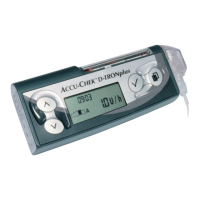9
Special Situations
Accu-Chek D-TRONplus insulin pump Reference Manual
159
Accu-Chek D-TRONplus insulin pump Reference Manual
158
This section includes:
9.1 Recommendations for daily use
9.2 Interruption of pump therapy
9.3 Your insulin pump and water
9.4 Electromagnetic fields and hazardous areas
9.5 Sports
9.6 Travelling
9.1 Recommendations for daily use
Warning: Training to use and using your Accu-Chek D-TRONplus insulin
pump requires the support of an experienced doctor and/or your health
care team. Regular visits with your doctor and/or your health care team
are absolutely essential during insulin pump therapy. Only change your
personal settings after consulting your doctor and/or your health care
team. Always follow the instructions given by your doctor and/or your
health care team.
Successful pump therapy requires frequent self-monitoring of blood glucose levels, at
least four times a day, or as directed by your health care team.
Insulin pump or infusion
set causes
Disconnecting infusion set
at luer lock end while set is
inserted in body
Incorrect programming or
basal rates not matched with
needs
Incorrect time setting
Priming the infusion set while
it is inserted in the body
Suggested actions
When changing the cartridge, adapter or infusion
set, disconnect at the site. Disconnecting at the
luer (adapter) end may cause unintended insulin
delivery.
Always review any changes made in basal rate
programming. Check with your health care team
about possible rate adjustment.
The correct hourly basal rate can not be delivered
if the time is incorrect. Check the time on a
regular basis and when replacing the PowerPack.
Priming automatically delivers 25 units* of
insulin from the cartridge. Never prime with
the infusion set connected to your body;
you risk unintended insulin delivery.
* This parameter may vary based on the standard configuration of your insulin pump
and changes made using the Accu-Chek DiaLog Pump Programming tool.
Other causes
Increased physical activity
Medication other than insulin
Suggested actions
Most people need less insulin when they are
more active. Check with your health care team
about reducing insulin for increased activity
using the temporary basal rate decrease.
Some medications other than insulin may affect
your blood glucose level. Check with your
pharmacist or doctor if your medications may
have this effect and ask how to adjust rates
accordingly.

